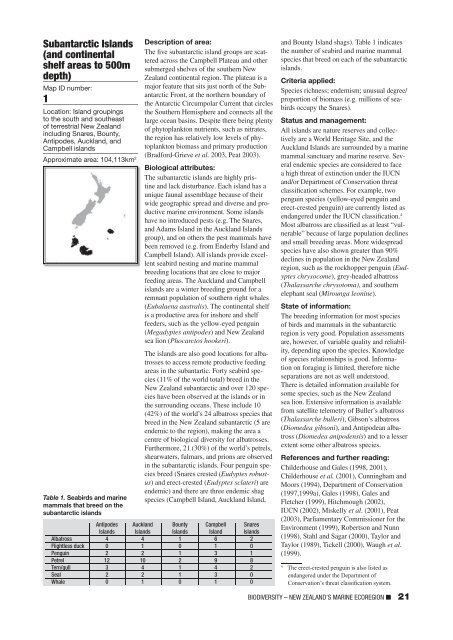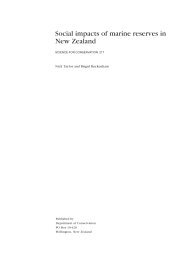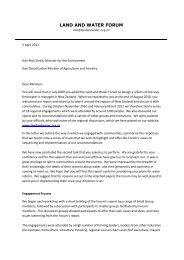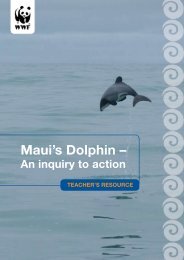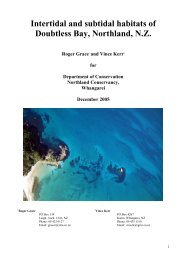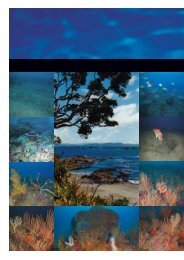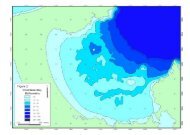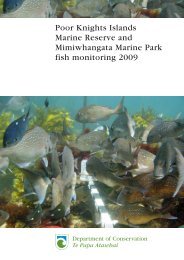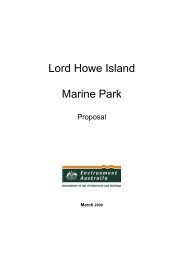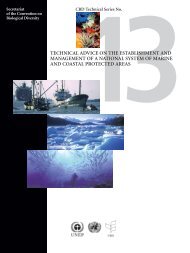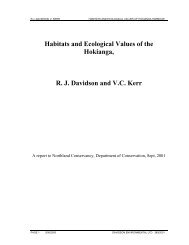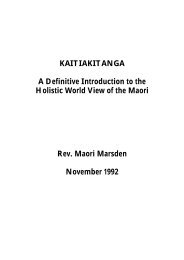WWF Shining a spotlight on the biodiversity of ... - MarineNZ.org.nz
WWF Shining a spotlight on the biodiversity of ... - MarineNZ.org.nz
WWF Shining a spotlight on the biodiversity of ... - MarineNZ.org.nz
You also want an ePaper? Increase the reach of your titles
YUMPU automatically turns print PDFs into web optimized ePapers that Google loves.
Subantarctic Islands<br />
(and c<strong>on</strong>tinental<br />
shelf areas to 500m<br />
depth)<br />
Map ID number:<br />
1<br />
Locati<strong>on</strong>: Island groupings<br />
to <strong>the</strong> south and sou<strong>the</strong>ast<br />
<strong>of</strong> terrestrial New Zealand<br />
including Snares, Bounty,<br />
Antipodes, Auckland, and<br />
Campbell islands<br />
Approximate area: 104,113km 2<br />
Table 1. Seabirds and marine<br />
mammals that breed <strong>on</strong> <strong>the</strong><br />
subantarctic islands<br />
Descripti<strong>on</strong> <strong>of</strong> area:<br />
The five subantarctic island groups are scattered<br />
across <strong>the</strong> Campbell Plateau and o<strong>the</strong>r<br />
submerged shelves <strong>of</strong> <strong>the</strong> sou<strong>the</strong>rn New<br />
Zealand c<strong>on</strong>tinental regi<strong>on</strong>. The plateau is a<br />
major feature that sits just north <strong>of</strong> <strong>the</strong> Subantarctic<br />
Fr<strong>on</strong>t, at <strong>the</strong> nor<strong>the</strong>rn boundary <strong>of</strong><br />
<strong>the</strong> Antarctic Circumpolar Current that circles<br />
<strong>the</strong> Sou<strong>the</strong>rn Hemisphere and c<strong>on</strong>nects all <strong>the</strong><br />
large ocean basins. Despite <strong>the</strong>re being plenty<br />
<strong>of</strong> phytoplankt<strong>on</strong> nutrients, such as nitrates,<br />
<strong>the</strong> regi<strong>on</strong> has relatively low levels <strong>of</strong> phytoplankt<strong>on</strong><br />
biomass and primary producti<strong>on</strong><br />
(Bradford-Grieve et al. 2003, Peat 2003).<br />
Biological attributes:<br />
The subantarctic islands are highly pristine<br />
and lack disturbance. Each island has a<br />
unique faunal assemblage because <strong>of</strong> <strong>the</strong>ir<br />
wide geographic spread and diverse and productive<br />
marine envir<strong>on</strong>ment. Some islands<br />
have no introduced pests (e.g. The Snares,<br />
and Adams Island in <strong>the</strong> Auckland Islands<br />
group), and <strong>on</strong> o<strong>the</strong>rs <strong>the</strong> pest mammals have<br />
been removed (e.g. from Enderby Island and<br />
Campbell Island). All islands provide excellent<br />
seabird nesting and marine mammal<br />
breeding locati<strong>on</strong>s that are close to major<br />
feeding areas. The Auckland and Campbell<br />
islands are a winter breeding ground for a<br />
remnant populati<strong>on</strong> <strong>of</strong> sou<strong>the</strong>rn right whales<br />
(Eubalaena australis). The c<strong>on</strong>tinental shelf<br />
is a productive area for inshore and shelf<br />
feeders, such as <strong>the</strong> yellow-eyed penguin<br />
(Megadyptes antipodes) and New Zealand<br />
sea li<strong>on</strong> (Phocarctos hookeri).<br />
The islands are also good locati<strong>on</strong>s for albatrosses<br />
to access remote productive feeding<br />
areas in <strong>the</strong> subantartic. Forty seabird species<br />
(11% <strong>of</strong> <strong>the</strong> world total) breed in <strong>the</strong><br />
New Zealand subantarctic and over 120 species<br />
have been observed at <strong>the</strong> islands or in<br />
<strong>the</strong> surrounding oceans. These include 10<br />
(42%) <strong>of</strong> <strong>the</strong> world’s 24 albatross species that<br />
breed in <strong>the</strong> New Zealand subantarctic (5 are<br />
endemic to <strong>the</strong> regi<strong>on</strong>), making <strong>the</strong> area a<br />
centre <strong>of</strong> biological diversity for albatrosses.<br />
Fur<strong>the</strong>rmore, 21 (30%) <strong>of</strong> <strong>the</strong> world’s petrels,<br />
shearwaters, fulmars, and pri<strong>on</strong>s are observed<br />
in <strong>the</strong> subantarctic islands. Four penguin species<br />
breed (Snares crested (Eudyptes robustus)<br />
and erect-crested (Eudyptes sclateri) are<br />
endemic) and <strong>the</strong>re are three endemic shag<br />
species (Campbell Island, Auckland Island,<br />
Antipodes Auckland Bounty Campbell Snares<br />
Islands Islands Islands Island Islands<br />
Albatross 4 4 1 6 2<br />
Flightless duck 0 1 0 1 0<br />
Penguin 2 2 1 3 1<br />
Petrel 12 10 2 9 8<br />
Tern/gull 3 4 1 4 2<br />
Seal 2 2 1 3 0<br />
Whale 0 1 0 1 0<br />
and Bounty Island shags). Table 1 indicates<br />
<strong>the</strong> number <strong>of</strong> seabird and marine mammal<br />
species that breed <strong>on</strong> each <strong>of</strong> <strong>the</strong> subantarctic<br />
islands.<br />
Criteria applied:<br />
Species richness; endemism; unusual degree/<br />
proporti<strong>on</strong> <strong>of</strong> biomass (e.g. milli<strong>on</strong>s <strong>of</strong> seabirds<br />
occupy <strong>the</strong> Snares).<br />
Status and management:<br />
All islands are nature reserves and collectively<br />
are a World Heritage Site, and <strong>the</strong><br />
Auckland Islands are surrounded by a marine<br />
mammal sanctuary and marine reserve. Several<br />
endemic species are c<strong>on</strong>sidered to face<br />
a high threat <strong>of</strong> extincti<strong>on</strong> under <strong>the</strong> IUCN<br />
and/or Department <strong>of</strong> C<strong>on</strong>servati<strong>on</strong> threat<br />
classificati<strong>on</strong> schemes. For example, two<br />
penguin species (yellow-eyed penguin and<br />
erect-crested penguin) are currently listed as<br />
endangered under <strong>the</strong> IUCN classificati<strong>on</strong>. 4<br />
Most albatross are classified as at least “vulnerable”<br />
because <strong>of</strong> large populati<strong>on</strong> declines<br />
and small breeding areas. More widespread<br />
species have also shown greater than 90%<br />
declines in populati<strong>on</strong> in <strong>the</strong> New Zealand<br />
regi<strong>on</strong>, such as <strong>the</strong> rockhopper penguin (Eudyptes<br />
chrysocome), grey-headed albatross<br />
(Thalassarche chrysotoma), and sou<strong>the</strong>rn<br />
elephant seal (Mirounga le<strong>on</strong>ine).<br />
State <strong>of</strong> informati<strong>on</strong>:<br />
The breeding informati<strong>on</strong> for most species<br />
<strong>of</strong> birds and mammals in <strong>the</strong> subantarctic<br />
regi<strong>on</strong> is very good. Populati<strong>on</strong> assessments<br />
are, however, <strong>of</strong> variable quality and reliability,<br />
depending up<strong>on</strong> <strong>the</strong> species. Knowledge<br />
<strong>of</strong> species relati<strong>on</strong>ships is good. Informati<strong>on</strong><br />
<strong>on</strong> foraging is limited, <strong>the</strong>refore niche<br />
separati<strong>on</strong>s are not as well understood.<br />
There is detailed informati<strong>on</strong> available for<br />
some species, such as <strong>the</strong> New Zealand<br />
sea li<strong>on</strong>. Extensive informati<strong>on</strong> is available<br />
from satellite telemetry <strong>of</strong> Buller’s albatross<br />
(Thalassarche bulleri), Gibs<strong>on</strong>’s albatross<br />
(Diomedea gibs<strong>on</strong>i), and Antipodean albatross<br />
(Diomedea anipodensis) and to a lesser<br />
extent some o<strong>the</strong>r albatross species.<br />
References and fur<strong>the</strong>r reading:<br />
Childerhouse and Gales (1998, 2001),<br />
Childerhouse et al. (2001), Cunningham and<br />
Moors (1994), Department <strong>of</strong> C<strong>on</strong>servati<strong>on</strong><br />
(1997,1999a), Gales (1998), Gales and<br />
Fletcher (1999), Hitchmough (2002),<br />
IUCN (2002), Miskelly et al. (2001), Peat<br />
(2003), Parliamentary Commissi<strong>on</strong>er for <strong>the</strong><br />
Envir<strong>on</strong>ment (1999), Roberts<strong>on</strong> and Nunn<br />
(1998), Stahl and Sagar (2000), Taylor and<br />
Taylor (1989), Tickell (2000), Waugh et al.<br />
(1999).<br />
4<br />
The erect-crested penguin is also listed as<br />
endangered under <strong>the</strong> Department <strong>of</strong><br />
C<strong>on</strong>servati<strong>on</strong>’s threat classificati<strong>on</strong> system.<br />
BIODIVERSITY – NEW ZEALAND’S MARINE ECOREGION ■ 21


